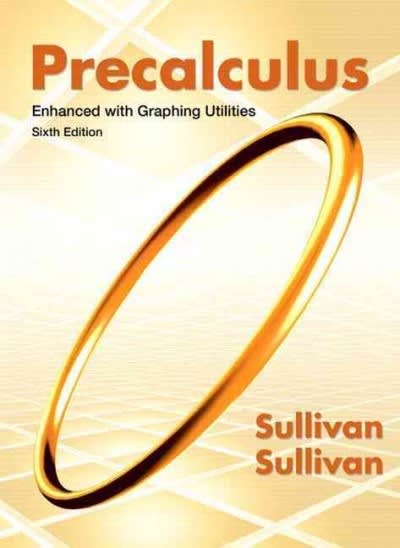Question
18. Suppose X1, X2, ..., Xn is a random sample from the uniform distribution on (0, 1) and Z be the sample range. What is
18. Suppose X1, X2, ..., Xn is a random sample from the uniform distribution
on (0, 1) and Z be the sample range. What is the probability that Z is less
than or equal to 0.5?
19. Let X1, X2, ..., X9 be a random sample from a uniform distribution on
the interval [1, 12]. Find the probability that the next to smallest is greater
than or equal to 4?
20. A machine needs 4 out of its 6 independent components to operate. Let
X1, X2, ..., X6 be the lifetime of the respective components. Suppose each is
exponentially distributed with parameter ?. What is the probability density
function of the machine lifetime?
21. Suppose X1, X2, ..., X2n+1 is a random sample from the uniform distribution on (0, 1). What is the probability density function of the sample
median X(n+1)
. An insurance company writes policies for a large number of newly-licensed
drivers each year. Suppose 40% of these are low-risk drivers, 40% are
moderate risk, and 20% are high risk. The company has no way to know which
group any individual driver falls in when it writes the policies. None of the
low-risk drivers will have an at-fault accident in the next year, but 10% of the
moderate-risk and 20% of the high-risk drivers will have such an accident. If a
driver has an at-fault accident in the next year, what is the probability that he or
she is high-risk?
25. You are to participate in an exam for which you had no chance to study, and for
that reason cannot anything but guess for each question (all questions being
of the multiple choice type, so the chance of guessing the correct answer for
each question is 1/d, d being the number of options (distractors) per question;
2#$
2 $
2$" $
,$"/2')=22'=>22
-"!)--2, -)"
2
#;:%#0""#$"#)$#6#"
#70+)$5
+#"-$)"0"/, -)"2
-
"+,) $+2
- )#)$);:#0)$#$)"
"#0$#"$"2
$"+"$#$)""##$2
0
- )$#$#$$+0,#$) 2)"
-3#
##$#0
0
)0
#0
""-$#$2
- $#0
)$$"#0$$"+"$#+$)""#2
$- )$$5
#,$) %2
$"3##$"$)""##
#$-$6 ##$71
2B0C0A0;:0C
2=0A0?0B0?
2?0?0?0?0?
20=0>0=
2=0:0C0
-"2) #>:F$#"+5"#"*"#0>:F""$"#0<:f>
"#2
-#+-$++") -*)"*"#+$
+"$#$ #2$+5"#"*"#+*$5)$$$,$
-"0)$;:F$"$5"#<:f>
$2 "*"#$5)$$$,$-"0+$#$ "$-$$"
##5"#/
=:2)"$ "% $,"+-)$#$)-0"$$"#
$)$)##"!)#%6!)#%#$)% $- 0#
$)##$""$#+""!)#%#;40$)"
220so in case of a 4-choice question, your guess chance is 0.25). Your instructor
offers you the opportunity to choose amongst the following exam formats: I. 6
questions of the 4-choice type; you pass when 5 or more answers are correct;
II. 5 questions of the 5-choice type; you pass when 4 or more answers are
correct; III. 4 questions of the 10-choice type; you pass when 3 or more
answers are correct. Rank the three exam formats according to their
attractiveness. It should be clear that the format with the highest probability to
pass is the most attractive format. Which would you choose and why?
26. Consider the question of whether the home team wins more than half of its
games in the National Basketball Association. Suppose that you study a simple
random sample of 80 professional basketball games and find that 52 of them
are won by the home team.
a. Assuming that there is no home court advantage and that the home team
therefore wins 50% of its games in the long run, determine the probability that
the home team would win 65% or more of its games in a simple random
sample of 80 games.
b. Does the sample information (that 52 of a random sample of 80 games are
won by the home team) provide strong evidence that the home team wins more
than half of its games in the long run? Explain.
27. A refrigerator contains 6 apples, 5 oranges, 10 bananas, 3 pears, 7 peaches, 11
plums, and 2 mangos.
a. Imagine you stick your hand in this refrigerator and pull out a piece of fruit
at random. What is the probability that you will pull out a pear?
b. Imagine now that you put your hand in the refrigerator and pull out a piece
of fruit. You decide you do not want to eat that fruit so you put it back into the
refrigerator and pull out another piece of fruit. What is the probability that the
first piece of fruit you pull out is a banana and the second piece you pull out is
an apple?
c. What is the probability that you stick your hand in the refrigerator one time
and pull out a mango or an orange




Step by Step Solution
There are 3 Steps involved in it
Step: 1

Get Instant Access to Expert-Tailored Solutions
See step-by-step solutions with expert insights and AI powered tools for academic success
Step: 2

Step: 3

Ace Your Homework with AI
Get the answers you need in no time with our AI-driven, step-by-step assistance
Get Started


